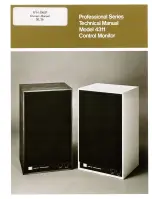
5
5
5
5////8/2007
8/2007
8/2007
8/2007
32
32
32
32
5.2
5.2
5.2
5.2 SSSS
OFTWARE
OFTWARE
OFTWARE
OFTWARE
PPPP
ARAMETERS
ARAMETERS
ARAMETERS
ARAMETERS
Below is a description of all software parameters used to control the AC4424.
5.2.1
5.2.1
5.2.1
5.2.1 RF Architecture (Server
RF Architecture (Server
RF Architecture (Server
RF Architecture (Server----Client/Peer
Client/Peer
Client/Peer
Client/Peer----to
to
to
to----Peer)
Peer)
Peer)
Peer)
The Server controls the system timing by sending out regular beacons (transparent to the
transceiver Host), which contain system timing information. This timing information
synchronizes the Client radios to the Server.
Each network should consist of only one Server. There should never be two Servers on the
same RF Channel Number
RF Channel Number
RF Channel Number
RF Channel Number in the same coverage area, as the interference between the two
Servers will severely hinder RF communications.
In Server-Client architecture, the Server communicates with the Clients and the Clients only
only
only
only
communicate with the Server. Enabling Peer
Peer
Peer
Peer----to
to
to
to----Peer Mode
Peer Mode
Peer Mode
Peer Mode will allow all radios on the network
to communicate with each other. Note: All transc
Note: All transc
Note: All transc
Note: All transceivers on the same network must have the
eivers on the same network must have the
eivers on the same network must have the
eivers on the same network must have the
same setting for Peer
same setting for Peer
same setting for Peer
same setting for Peer----to
to
to
to----Peer and there must still be one, and only one, Server present in a
Peer and there must still be one, and only one, Server present in a
Peer and there must still be one, and only one, Server present in a
Peer and there must still be one, and only one, Server present in a
Peer
Peer
Peer
Peer----to
to
to
to----Peer network.
Peer network.
Peer network.
Peer network.
5.2.2
5.2.2
5.2.2
5.2.2 RF Mode
RF Mode
RF Mode
RF Mode
Acknowledge Mode
Acknowledge Mode
Acknowledge Mode
Acknowledge Mode
In Addressed Acknowledge Mode, the RF packet is sent out to the receiver designated by the
Destination Address
Destination Address
Destination Address
Destination Address. Transmit Retries
Transmit Retries
Transmit Retries
Transmit Retries are used to increase the odds of successful delivery to
the intended receiver. Transparent to the OEM Host, the sending transceiver will send the RF
packet to the intended receiver. If the receiver receives the packet free of errors, it will tell
the sender. If the sender does not receive this acknowledge, it will assume the packet was
never received and retry the packet. This will go on until the packet is successfully received
or the transmitter exhausts all of its retries. The received packet will only be sent to the OEM
Host if and when it is received free of errors.
In Broadcast Acknowledge Mode, the RF packet is broadcast out to all eligible receivers on
the network. In order to increase the odds of successful delivery, Broadcast Attempts
Broadcast Attempts
Broadcast Attempts
Broadcast Attempts are
used to increase the odds of successful delivery to the intended receiver(s). Transparent to
the OEM Host, the sending transceiver will send the RF packet to the intended receiver. If the
receiver detects a packet error, it will throw out the packet. This will go on until the packet is
successfully received or the transmitter exhausts all of its attempts. Once the receiver
successfully receives the packet it will send the packet to the OEM Host. It will throw out any
duplicates caused by further Broadcast Attempts. The received packet will only be sent to
the OEM Host if it is received free of errors.












































